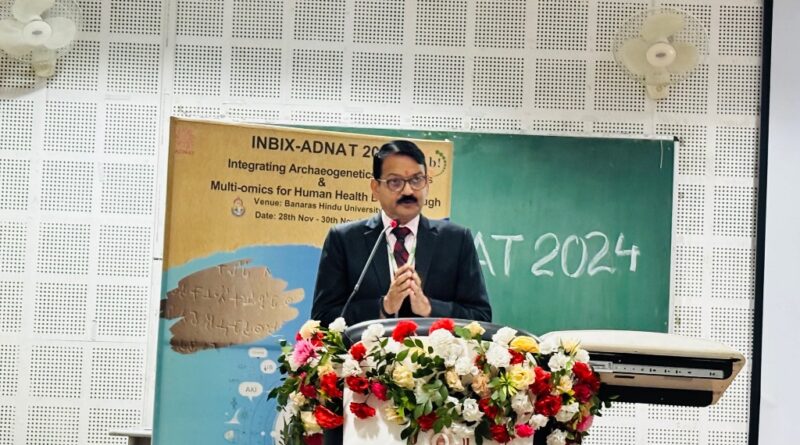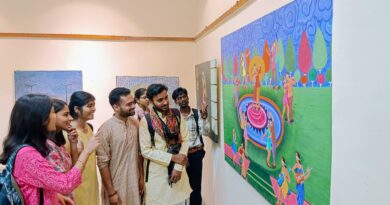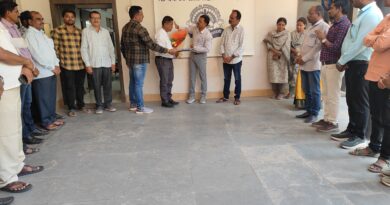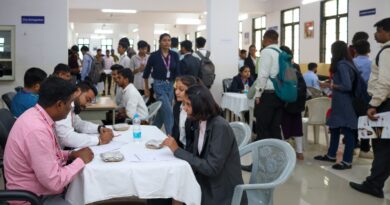Harappan civilisation gave a new dimension to the origin of India- Prof BV Sharma
Varanasi : In a collaborative effort between BioClues and ADNET organizations, the three-day international conference began today at the Mahamana Hall of Banaras Hindu University (BHU). The inaugural session and keynote speeches for the day were organized in the presence of 300 young scientists and distinguished guests. The event commenced with the ceremonial lighting of the lamp and garlanding to Mahamana, followed by the university Kulgeet. The session was chaired by Prof. S.M. Singh, Dean of the Institute of Science, and Prof. Singravel Head of the Department, Zoology.

This symposium, dedicated to the centenary of the discovery of the Harappan Civilization, featured opening addresses by Dr. Prashant N. Suravjhala, Founder of BioClues, and Prof. Satish Kumar, President of ADNAT, highlighting their organizations’ contributions to scientific research. Dr. Suravjhala explained on BioClues’ 20-year journey, emphasizing its role in guiding researchers in academic writing and publication, thereby fostering innovation in the scientific domain. Prof. Satish Kumar elaborated on ADNAT over 30 years of dedication to DNA research, underlining its pivotal role in advancing scientific knowledge.

Dr. G.K. Goswami, ADG and Director of the Uttar Pradesh Forensic Science Institute, He recounted the scientific challenges faced by police during early times and emphasized the growing integration of science in legal and investigative processes. He shared his experiences from his tenure as SP of Varanasi during the aftermath of the 1998 bombings. Dr. Goswami urged researchers to pursue work with direct societal benefits and highlighted the critical role of science in justice and law enforcement through practical examples rather than book knowledge.
The guest of honor, Prof. Bhallamudi V. Sharma, Director of the Anthropological Survey of India (AnSI), delivered the keynote talk on “AnSI and Paleoethnobotanical Research: Achievements and Current Endeavors.” Prof. Sharma commenced his address by dedicating the symposium to the 100-year milestone of the discovery of the Harappan Civilization, highlighting the significant contributions of anthropologists in the exploration of Harappa and Mohenjo-Daro. He detailed AnSI’s pivotal role in studying ancient human interactions, utilizing fossil records, archaeological discoveries, and other evidence. Prof. Sharma stressed the interdisciplinary approaches, integrating archaeology, genetics, and developmental biology, which have enriched the understanding of human evolution and societal development. He further discussed recent efforts to advance paleoanthropological research, citing the discovery of Paleolithic skeletal remains in the Narmada Valley and AnSI’s significant involvement in these studies.

The event concluded with a vote of thanks delivered by Dr. K. Shree Manjari, followed by the inauguration of the e-abstract booklet by the chief guest.
By welcoming the guests, convener Dr Chandana Basu said that this conference served as an inspiring platform for students and researchers, fostering innovation and collaboration in the fields of science and research.
The Austroasiatic languages spread from Southeast Asia- Prof George van Driem
One of global oldest language Austroasiatic has roots in Southeast Asia and from there it dispersed to various parts of world. He highlighted the intriguing interconnections between language and genetics. He showed the shared evolutionary trajectories of Nicobarese and Austroasiatic-speaking populations, offering new insights into their historical migrations and interactions. A distinguished linguist and scholar, Prof. Van Driem is internationally renowned for his pioneering work in the interdisciplinary study of linguistics, anthropology, and genetics.
Linguistics expert from Delhi University Prof. Tanmoy Bhattacharya discussed the nexus of various languages group in Northeast India. Tai-Kadai language group. In his lecture, he explored the challenges and implications of mapping linguistic identity in a region marked by its rich yet fragmented linguistic heritage. This session was chaired by Prof. V. Ramnathan, IIT BHU.






